Effect of Steel Fibers on the Hysteretic Performance of Concrete Beams with Steel Reinforcement—Tests and Analysis
Abstract
:1. Introduction
2. Materials and Methods
2.1. Experimental Investigation
2.1.1. Characteristics of the Beam Specimens
2.1.2. Test Rig and Loading Histories
2.1.3. Properties of the SFRC
2.2. Proposed Model, Constitutive Relationships of the Materials and Nonlinear FE Analysis
2.2.1. SFRC under Reversal Compression
2.2.2. SFRC under Reversal Tension
2.2.3. Modeling of Steel Reinforcement
2.2.4. Element Types
2.2.5. Boundary Conditions
2.2.6. Loading, Mesh and Convergence
2.2.7. FE Simulation of the Tested Beams and Material Input
3. Results and Discussion
3.1. Verification of the Model
3.2. Analysis of the Hysteric Behavior and Accuracy of the Proposed Model
3.2.1. Simplification of the hysteretic Loop
3.2.2. Degradation Analysis of Strength and Stiffness
3.2.3. Accuracy of the Model
3.3. Effect of Steel Fibers on the Hysteretic Response
4. Conclusions
- The performed cyclic loading tests of slender and deep beams indicate that SFRC beams with increased values of the fiber factor, F, exhibit an improved hysteretic response in terms of stiffness, load-bearing capacity, deformation, energy dissipation ability and cracking behavior. The favorable effect of the used steel fibers on the overall seismic response has been highlighted since SFRC specimens maintain their integrity through the imposed reversal cyclic tests exhibiting higher values of load-bearing capacity and cumulative energy absorbed per loading cycle than the corresponding plain concrete beams without fibers. It is noted that steel fibers with a volume fraction of 1% and 3% provided a 17% and 28% increase in the energy dissipation, respectively, for the case of the flexural beams. This increase was much higher in the shear-critical beams without stirrups. In particular, the ratio of the cumulative energy absorbed of the last loading cycle of the SFRC deep beams to the corresponding energy of the reference plain concrete beams was 1.60, 2.40, 3.09 and 3.47 for beams with fiber factor F = 0.3, 0.4, 0.6 and 0.8, respectively.
- Shear-critical beams reinforced with longitudinal bars and steel fibers without stirrups exhibited comparable hysteretic response in terms of strength and absorbed energy with the corresponding deep beams reinforced with bars and stirrups without steel fibers. Although more tests are still required to provide wide-ranging conclusions, it is indicated that a potential replacement of stirrups with steel fibers could be achieved under certain circumstances that depend on the ability of the SFRC beam to satisfy pre-set strength and ductility requirements.
- The developed FE simulation considers the nonlinearities of the materials by a smeared crack approach with tension softening and residual stiffness effect. The favorable influence of the steel fibers is evaluated according to their characteristics and content in order to achieve a more realistic prediction of SFRC behavior under compression and tension.
- The direct tension experimental results of SFRC specimens carried out in this study verify the analytical predictions of the proposed tensional model. These tests indicate that steel fibers substantially improve the post-cracking tensile behavior and the residual stress versus crack width curve according to the values of the fiber factor, F. Specifically, the value of the maximum post-cracking residual tensile stress was found to be 0.22, 0.33, 0.40 and 0.57 times the value of the tensile strength for SFRC mixtures with fiber factor F = 0.3, 0.4, 0.6 and 0.8, respectively. Furthermore, this fiber factor is a more efficient parameter than the volume fraction for the evaluation of the steel fiber contribution.
- The developed nonlinear FE analysis accurately predicts the overall hysteretic response and points out the beneficial effect of the added fibers. Comparisons between the test and numerical results reveal that the developed nonlinear FE analysis with a smeared crack model that takes into account the tension softening and residual stiffness effect accurately predicts the hysteretic response of realistic SFRC beams with steel reinforcement. Furthermore, its validity and accuracy have been checked by calculating the discrepancies between test data and numerical predictions for various variables, such as load, deformation, and stiffness. The mean absolute errors of these variables were found to be satisfactorily low for the tested beams.
Author Contributions
Funding
Acknowledgments
Conflicts of Interest
References
- Conforti, A.; Zerbino, R.; Plizzari, G.A. Influence of steel, glass and polymer fibers on the cracking behavior of reinforced concrete beams under flexure. Struct. Concr. 2019, 20, 133–143. [Google Scholar] [CrossRef] [Green Version]
- Smarzewski, P. Effect of curing period on properties of steel and polypropylene fibre reinforced ultra-high performance concrete. Mater. Sci. Eng. 2017, 245, 032059. [Google Scholar] [CrossRef]
- Bencardino, F.; Nisticò, M.; Verre, S. Experimental investigation and numerical analysis of bond behavior in SRG-strengthened masonry prisms using UHTSS and stainless-steel fibers. Fibers 2020, 8, 8. [Google Scholar] [CrossRef] [Green Version]
- Cuenca, E.; Ferrara, L. Self-healing capacity of fiber reinforced cementitious composites. State of the art and perspectives. KSCE J. Civ. Eng. 2017, 21, 2777–2789. [Google Scholar] [CrossRef]
- Guerini, V.; Conforti, A.; Plizzari, G.; Kawashima, S. Influence of steel and macro-synthetic fibers on concrete properties. Fibers 2018, 6, 47. [Google Scholar] [CrossRef] [Green Version]
- Martinelli, E.; Lima, C.; Pepe, M.; Caggiano, A.; Faella, C. Post-cracking response of hybrid recycled/industrial steel fiber-reinforced concrete. ACI Spec. Publ. 2018, 326, 64.1–64.10. [Google Scholar]
- Belletti, B.; Cerioni, R.; Meda, A.; Plizzari, G. Design aspects on steel fiber-reinforced concrete pavements. J. Mater. Civ. Eng. 2008, 20, 599–607. [Google Scholar] [CrossRef]
- Bencardino, F. Mechanical parameters and post-cracking behaviour of HPFRC according to three-point and four-point bending test. Adv. Civ. Eng. 2013, 2013, 179712. [Google Scholar] [CrossRef] [Green Version]
- Caggiano, A.; Gambarelli, S.; Martinelli, E.; Nisticò, N.; Pepe, M. Experimental characterization of the post-cracking response in hybrid steel/polypropylene fiber-reinforced concrete. Constr. Build. Mater. 2016, 125, 1035–1043. [Google Scholar] [CrossRef]
- Tsonos, A.-D.G. Steel fiber high-strength reinforced concrete: A new solution for earthquake strengthening of old R/C structures. WIT Trans. Built Env. 2009, 104, 153–164. [Google Scholar]
- Vougioukas, E.; Papadatou, M. A model for the prediction of the tensile strength of fiber-reinforced concrete members, before and after cracking. Fibers 2017, 5, 27. [Google Scholar] [CrossRef] [Green Version]
- Abambres, M.; Lantsoght, E.O.L. ANN-Based Shear Capacity of Steel Fiber-Reinforced Concrete Beams without Stirrups. Fibers 2019, 7, 88. [Google Scholar] [CrossRef] [Green Version]
- Campione, G.; Minafo, G. Behaviour of concrete deep beams with openings and low shear span-to-depth ratio. Eng. Struct. 2012, 41, 294–306. [Google Scholar] [CrossRef]
- Ma, K.; Qi, T.; Liu, H.; Wang, H. Shear behavior of hybrid fiber reinforced concrete deep beams. Materials 2018, 11, 2023. [Google Scholar] [CrossRef] [Green Version]
- Smarzewski, P. Analysis of failure mechanics in hybrid fibre-reinforced high-performance concrete deep beams with and without openings. Materials 2019, 12, 101. [Google Scholar] [CrossRef] [Green Version]
- Cuenca, E.; Echegaray-Oviedo, J.; Serna, P. Influence of concrete matrix and type of fiber on the shear strength behavior of self-compacting fiber reinforced concrete. Compos. Part B Eng. 2015, 75, 135–147. [Google Scholar] [CrossRef]
- Tsonos, A.-D.G. Ultra-high-performance fiber reinforced concrete: An innovative solution for strengthening old R/C structures and for improving the FRP strengthening method. WIT Trans. Eng. Sci. 2009, 64, 273–284. [Google Scholar]
- Leone, M.; Centonze, G.; Colonna, D.; Micelli, F.; Aiello, M.A. Fiber-reinforced concrete with low content of recycled steel fiber: Shear behavior. Constr. Build. Mater. 2018, 161, 141–155. [Google Scholar] [CrossRef]
- Cucchiara, C.; Mendola, L.; Papia, M. Effectiveness of stirrups and steel fibres as shear reinforcement. Cem. Concr. Compos. 2004, 26, 777–786. [Google Scholar] [CrossRef]
- Zhao, J.; Liang, J.; Chu, L.; Shen, F. Experimental study on shear behavior of steel fiber reinforced concrete beams with high-strength reinforcement. Materials 2018, 11, 1682. [Google Scholar] [CrossRef] [Green Version]
- Torres, J.A.; Lantsoght, E.O.L. Influence of fiber content on shear capacity of steel fiber-reinforced concrete beams. Fibers 2019, 7, 102. [Google Scholar] [CrossRef] [Green Version]
- Tsonos, A.G.; Stylianidis, K. Seismic retrofit of beam-to-column joints with high-strength fiber jackets. Europ. Earthq. Eng. 2002, 16, 56–72. [Google Scholar]
- Amato, G.; Campione, G.; Cavaleri, L.; Minafo, G. Flexural behaviour of external R/C steel fibre reinforced beam-column joints. Europ. J. Env. Civ. Eng. 2011, 15, 1253–1276. [Google Scholar] [CrossRef]
- Kabir, M.R.; Alam, M.S.; Said, A.M.; Ayad, A. Performance of hybrid reinforced concrete beam column joint: A critical review. Fibers 2016, 4, 13. [Google Scholar] [CrossRef] [Green Version]
- Abbas, A.A.; Mohsin, S.M.S.; Cotsovos, D.M. Seismic response of steel fiber reinforced concrete beam-column joints. Eng. Struct. 2014, 59, 261–283. [Google Scholar] [CrossRef] [Green Version]
- Colajanni, P.; De Domenico, F.; Recupero, A.; Spinella, N. Concrete columns confined with fibre reinforced cementitious mortars: Experimentation and modelling. Constr. Build. Mater. 2014, 52, 375–384. [Google Scholar] [CrossRef]
- Cascardi, A.; Longo, F.; Micelli, F.; Aiello, M.A. Compressive strength of confined column with fiber reinforced mortar (FRM): New design-oriented-models. Constr. Build. Mater. 2017, 156, 387–401. [Google Scholar] [CrossRef]
- Chalioris, C.E.; Sfiri, E.F. Shear performance of steel fibrous concrete beams. Procedia Eng. 2011, 14, 2064–2068. [Google Scholar] [CrossRef] [Green Version]
- Chalioris, C.E.; Karayannis, C.G. Effectiveness of the use of steel fibers on the torsional behavior of flanged concrete beams. Cem. Concr. Compos. 2009, 31, 331–341. [Google Scholar] [CrossRef]
- Spinella, N.; Colajanni, P.; Recupero, A. Simple plastic model for shear critical SFRC beams. J. Struct. Eng. 2010, 136, 390–400. [Google Scholar] [CrossRef] [Green Version]
- Colajanni, P.; Recupero, A.; Spinella, N. Generalization of shear truss model to the case of SFRC beams with stirrups. Comput. Concr. 2012, 9, 227–244. [Google Scholar] [CrossRef]
- Spinella, N. Shear strength of full-scale steel fibre-reinforced concrete beams without stirrups. Comput. Concr. 2013, 11, 365–382. [Google Scholar] [CrossRef]
- Lantsoght, E.O.L. Database of shear experiments on steel fiber reinforced concrete beams without stirrups. Materials 2019, 12, 917. [Google Scholar] [CrossRef] [PubMed] [Green Version]
- Bernat, A.M.; Spinella, N.; Recupero, A.; Cladera, A. Mechanical model for the shear strength of steel fiber reinforced concrete (SFRC) beams without stirrups. Mater. Struct. 2020, 53, 1–20. [Google Scholar]
- Bischoff, P.H. Tension stiffening and cracking of steel fiber-reinforced concrete. ASCE J. Mat. Civ. Eng. 2003, 15, 174–182. [Google Scholar] [CrossRef]
- Meskenas, A.; Kaklauskas, G.; Daniunas, A.; Bacinskas, D.; Jakubovskis, R.; Gribniak, V.; Gelazius, V. Determination of the stress-crack opening relationship of SFRC by an inverse analysis. Mech. Compos. Mater. 2014, 49, 685–690. [Google Scholar] [CrossRef]
- Morelli, F.; Amico, C.; Salvatore, W.; Squeglia, N.; Stacul, S. Influence of tension stiffening on the flexural stiffness of reinforced concrete circular sections. Materials 2017, 10, 669. [Google Scholar] [CrossRef] [Green Version]
- Gribniak, V.; Arnautov, A.K.; Norkus, A.; Kliukas, R.; Tamulenas, V.; Gudonis, E.; Sokolov, A.V. Steel fibers: Effective way to prevent failure of the concrete bonded with FRP sheets. Adv. Mater. Sci. Eng. 2016, 2016, 10. [Google Scholar] [CrossRef] [Green Version]
- Gribniak, V.; Tamulenas, V.; Ng, P.-L.; Arnautov, A.K.; Gudonis, E.; Misiunaite, I. Mechanical behavior of steel fiber-reinforced concrete beams bonded with external carbon fiber sheets. Materials 2017, 10, 666. [Google Scholar] [CrossRef] [Green Version]
- Gribniak, V.; Ng, P.-L.; Tamulenas, V.; Misiunaite, I.; Norkus, A.; Šapalas, A. Strengthening of fibre reinforced concrete elements: Synergy of the fibres and external sheet. Sustainability 2019, 11, 4456. [Google Scholar] [CrossRef] [Green Version]
- Meda, A.; Minelli, F.; Plizzari, G.A. Flexural behaviour of RC beams in fibre reinforced concrete. Compos. Part B Eng. 2012, 43, 2930–2937. [Google Scholar] [CrossRef]
- Smarzewski, P. Flexural toughness of high-performance concrete with basalt and polypropylene short fibres. Adv. Civ. Eng. 2018, 2018, 5024353. [Google Scholar] [CrossRef] [Green Version]
- Gribniak, V.; Kaklauskas, G.; Kwan, H.; Bacinskas, D.; lbinas, D. Deriving stress-strain relationships for steel fiber concrete in tension from tests of beams with ordinary reinforcement. Eng. Struct. 2012, 42, 387–395. [Google Scholar] [CrossRef]
- Gribniak, V.; Kaklauskas, G.; Torres, L.; Daniunas, A.; Timinskas, E.; Gudonis, E. Comparative analysis of deformations and tension-stiffening in concrete beams reinforced with GFRP or steel bars and fibers. Compos. Part B Eng. 2013, 50, 158–170. [Google Scholar] [CrossRef]
- Kaklauskas, G.; Gribniak, V.; Meskenas, A.; Bacinskas, D.; Juozapaitis, A.; Sokolov, A.; Ulbinas, D. Experimental investigation of the deformation behavior of SFRC beams with an ordinary reinforcement. Mech. Compos. Mater. 2014, 50, 417–426. [Google Scholar] [CrossRef]
- Meskenas, A.; Gribniak, V.; Kaklauskas, G.; Sokolov, A.; Gudonis, E.; Rimkus, A. Experimental investigation of cracking behaviour of concrete beams reinforced with steel fibres produced in Lithuania. Baltic J. Road Bridge. Eng. 2017, 12, 82–87. [Google Scholar] [CrossRef]
- Gribniak, V.; Arnautov, A.K.; Norkus, A.; Tamulenas, V.; Gudonis, E.; Sokolov, A. Experimental investigation of the capacity of steel fibers to ensure the structural integrity of reinforced concrete specimens coated with CFRP sheets. Mech. Compos. Mater. 2016, 52, 401–410. [Google Scholar] [CrossRef]
- Ng, P.; Gribniak, V.; Jakubovskis, R.; Rimkus, A. Tension stiffening approach for deformation assessment of flexural reinforced concrete members under compressive axial load. Struct. Concr. 2019, 20, 2056–2068. [Google Scholar] [CrossRef] [Green Version]
- Plizzari, G.A.; Cangiano, S.; Cere, N. Postpeak behavior of fiber-reinforced concrete under cyclic tensile loads. ACI Mater. J. 2000, 97, 182–192. [Google Scholar]
- Graeff, A.G.; Pilakoutas, K.; Neocleous, K.; Peres, M.V.N.N. Fatigue resistance and cracking mechanism of concrete pavements reinforced with recycled steel fibres recovered from post-consumer tyres. Eng. Struct. 2012, 45, 385–395. [Google Scholar] [CrossRef]
- Li, B.; Xu, L.; Chi, Y.; Huang, B.; Li, C. Experimental investigation on the stress-strain behavior of steel fiber reinforced concrete subjected to uniaxial cyclic compression. Constr. Build. Mater. 2017, 140, 109–118. [Google Scholar] [CrossRef]
- Li, B.; Chi, Y.; Xu, L.; Li, C.; Shi, Y. Cyclic tensile behavior of SFRC: Experimental research and analytical model. Constr. Build. Mater. 2018, 190, 1236–1250. [Google Scholar] [CrossRef]
- Gonzalez, D.C.; Vicente, M.A.; Ahmad, S. Effect of cyclic loading on the residual tensile strength of steel fiber-reinforced high-strength concrete. ASCE J. Mater. Civ. Eng. 2015, 27, 04014241. [Google Scholar] [CrossRef]
- Daniel, L.; Loukili, A. Behavior of high-strength fiber-reinforced concrete beams under cyclic loading. ACI Struct. J. 2002, 99, 248–256. [Google Scholar]
- Kotsovos, G.; Zeris, C.; Kotsovos, M. The effect of steel fibers on the earthquake-resistant design of reinforced concrete structures. Mater. Struct. 2007, 40, 175–188. [Google Scholar] [CrossRef]
- Harajli, M.H.; Gharzeddine, O. Effect of steel fibers on bond performance of steel bars in NSC and HSC under load reversals. ASCE J. Mater. Civ. Eng. 2007, 19, 864–873. [Google Scholar] [CrossRef]
- Campione, G.; Mangiavillano, M.L. Fibrous reinforced concrete beams in flexure: Experimental investigation, analytical modelling and design considerations. Eng. Struct. 2008, 30, 2970–2980. [Google Scholar] [CrossRef]
- Tavallali, H.; Lepage, A.; Rautenberg, J.M.; Pujol, S. Concrete beams reinforced with high-strength steel subjected to displacement reversals. ACI Struct. J. 2014, 111, 1037–1048. [Google Scholar] [CrossRef]
- Caratelli, A.; Meda, A.; Rinaldi, Z. Monotonic and cyclic behaviour of lightweight concrete beams with and without steel fiber reinforcement. Constr. Build. Mater. 2016, 122, 23–35. [Google Scholar] [CrossRef]
- Parra-Montesinos, G.J.; Chompreda, P. Deformation capacity and shear strength of fiber-reinforced cement composite flexural members subjected to displacement reversals. ASCE J. Struct. Eng. 2007, 133, 421–431. [Google Scholar] [CrossRef]
- Luo, J.W.; Vecchio, F.J. Behavior of steel fiber-reinforced concrete under reversed cyclic shear. ACI Struct. J. 2016, 113, 75–84. [Google Scholar] [CrossRef] [Green Version]
- Chalioris, C.E. Steel fibrous RC beams subjected to cyclic deformations under predominant shear. Eng. Struct. 2013, 49, 104–118. [Google Scholar] [CrossRef]
- Rousakis, T.C.; Manolitsi, G.; Karabinis, A.I. FRP strengthening of RC columns: Parametric finite element analyses of bar quality effect. In Proceedings of the 1st Asia-Pacific Conference on FRP in Structures (APFIS 2007), Hong-Kong, China, 12–14 December 2007; Smith, S.T., Ed.; International Institute for FRP in Construction: Winnipeg, MB, Canada, 2007. [Google Scholar]
- Gómez, J.; Torres, L.; Barris, C. Characterization and simulation of the bond response of NSM FRP reinforcement in concrete. Materials 2020, 13, 1770. [Google Scholar] [CrossRef] [Green Version]
- Zhelyazov, T. Structural Materials: Identification of the constitutive models and assessment of the material response in structural elements strengthened with externally-bonded composite material. Materials 2020, 13, 1272. [Google Scholar] [CrossRef] [PubMed] [Green Version]
- Chalioris, C.E.; Kosmidou, P.-M.K.; Karayannis, C.G. Cyclic response of steel fiber reinforced concrete slender beams: An experimental study. Materials 2019, 12, 1398. [Google Scholar] [CrossRef] [Green Version]
- Dassault Systèmes Simulia System Information. In Abaqus 2017 User’s Manual; Version 6.12.1; SIMULIA: Providence, RI, USA, 2017.
- Lubliner, J.; Oliver, J.; Oller, S.; Oñate, E. A plastic-damage model for concrete. Int. J. Solids Struct. 1989, 25, 299–326. [Google Scholar] [CrossRef]
- Karayannis, C.G. A numerical approach to steel-fibre reinforced concrete under torsion. Struct. Eng. Rev. 1995, 7, 83–91. [Google Scholar]
- Lantsoght, E.O.L. How do steel fibers improve the shear capacity of reinforced concrete beams without stirrups? Compos. Part B Eng. 2019, 175, 107079. [Google Scholar] [CrossRef]
- Yun, H.-D.; Lim, S.H.; Choi, W.-C. Effects of reinforcing fiber strength on mechanical properties of high-strength concrete. Fibers 2019, 7, 93. [Google Scholar] [CrossRef] [Green Version]
- Neves, R.; Almeida, J. Compressive behaviour of steel fibre reinforced concrete. Struct. Concr. 2005, 6, 1–8. [Google Scholar] [CrossRef]
- Bencardino, F.; Rizzuti, L.; Spadea, G. Stress-strain behavior of steel fiber-reinforced concrete in compression. ASCE J. Mater. Civ. Eng. 2008, 20, 255–263. [Google Scholar] [CrossRef]
- Chalioris, C.E.; Liotoglou, F.A. Tests and simplified behavioral model for steel fibrous concrete under compression. In Advances in Civil Engineering and Building Materials IV.; Chang, S.-Y., Al Bahar, S.K., Husain, A.-A.M., Zhao, J., Eds.; CRC Press/Balkema: Leiden, The Netherlands, 2015; pp. 195–199. [Google Scholar]
- Lee, S.-C.; Oh, J.-H.; Cho, J.-Y. Compressive behavior of fiber-reinforced concrete with end-hooked steel fibers. Materials 2015, 8, 1442–1458. [Google Scholar] [CrossRef] [PubMed] [Green Version]
- Zhao, M.; Zhang, B.; Shang, P.; Fu, Y.; Zhang, X.; Zhao, S. Complete stress–strain curves of self-compacting steel fiber reinforced expanded-shale lightweight concrete under uniaxial compression. Materials 2019, 12, 2979. [Google Scholar] [CrossRef] [PubMed] [Green Version]
- Chalioris, C.E.; Panagiotopoulos, T.A. Flexural analysis of steel fibre-reinforced concrete members. Comput. Concr. 2018, 22, 11–25. [Google Scholar]
- Choi, W.-C.; Jung, K.-Y.; Jang, S.-J.; Yun, H.-D. The influence of steel fiber tensile strengths and aspect ratios on the fracture properties of high-strength concrete. Materials 2019, 12, 2105. [Google Scholar] [CrossRef] [Green Version]
- Wang, Z.L.; Wu, J.; Wang, J.G. Experimental and numerical analysis on effect of fiber aspect ratio on mechanical properties of SFRC. Constr. Build. Mater. 2010, 24, 559–565. [Google Scholar] [CrossRef]
- Choi, S.W.; Choi, J.; Lee, S.C. Probabilistic analysis for strain-hardening behavior of high-performance fiber-reinforced concrete. Materials 2019, 12, 2399. [Google Scholar] [CrossRef] [Green Version]
- Bezerra, A.; Maciel, P.S.; Corrêa, E.; Soares Junior, P.R.R.; Aguilar, M.T.P.; Cetlin, P.R. Effect of high temperature on the mechanical properties of steel fiber-reinforced concrete. Fibers 2019, 7, 100. [Google Scholar] [CrossRef] [Green Version]
- Karayannis, C.G. Smeared crack analysis for plain concrete in torsion. ASCE J. Struct. Eng. 2000, 126, 638–645. [Google Scholar] [CrossRef]
- Karayannis, C.G.; Chalioris, C.E. Experimental validation of smeared analysis for plain concrete in torsion. ASCE J. Struct. Eng. 2000, 126, 646–653. [Google Scholar] [CrossRef]
- Rimkus, A.; Cervenka, V.; Gribniak, V.; Cervenka, J. Uncertainty of the smeared crack model applied to RC beams. Eng. Fract. Mech. 2020, 233, 107088. [Google Scholar] [CrossRef]
- Kytinou, K.V.; Chalioris, C.E. Analysis of residual flexural stiffness of steel fiber-reinforced concrete beams with steel reinforcement. Materials 2020, 13, 2698. [Google Scholar] [CrossRef] [PubMed]
- Karayannis, C.G. Nonlinear analysis and tests of steel-fiber concrete beams in torsion. Struct. Eng. Mech. 2000, 9, 323–338. [Google Scholar] [CrossRef]
- Mudadu, A.; Tiberti, G.; Plizzari, G.A.; Morbi, A. Post-cracking behavior of polypropylene fiber reinforced concrete under bending and uniaxial tensile tests. Struct. Concr. 2019, 20, 1411–1424. [Google Scholar] [CrossRef]
- Mudadu, A.; Tiberti, G.; Germano, F.; Plizzari, G.A.; Morbi, A. The effect of fiber orientation on the post-cracking behavior of steel fiber reinforced concrete under bending and uniaxial tensile tests. Cem. Concr. Compos. 2018, 93, 274–288. [Google Scholar] [CrossRef]
- Bencardino, F.; Rizzuti, L.; Spadea, G.; Swamy, R.N. Experimental evaluation of fiber reinforced concrete fracture properties. Compos. Part B Eng. 2010, 41, 17–24. [Google Scholar] [CrossRef]
- Bazant, Z.P.; Oh, B.H. Crack band theory for fracture of concrete. Mater. Constr. 1983, 16, 155–177. [Google Scholar] [CrossRef] [Green Version]
- Genikomsou, A.S.; Polak, M.A. Finite element analysis of punching shear of concrete slabs using damaged plasticity model in ABAQUS. Eng. Struct. 2015, 98, 38–48. [Google Scholar] [CrossRef]
- Chalioris, C.E. Analytical approach for the evaluation of minimum fiber factor required for steel fibrous concrete beams under combined shear and flexure. Constr. Build. Mater. 2013, 43, 317–336. [Google Scholar] [CrossRef]





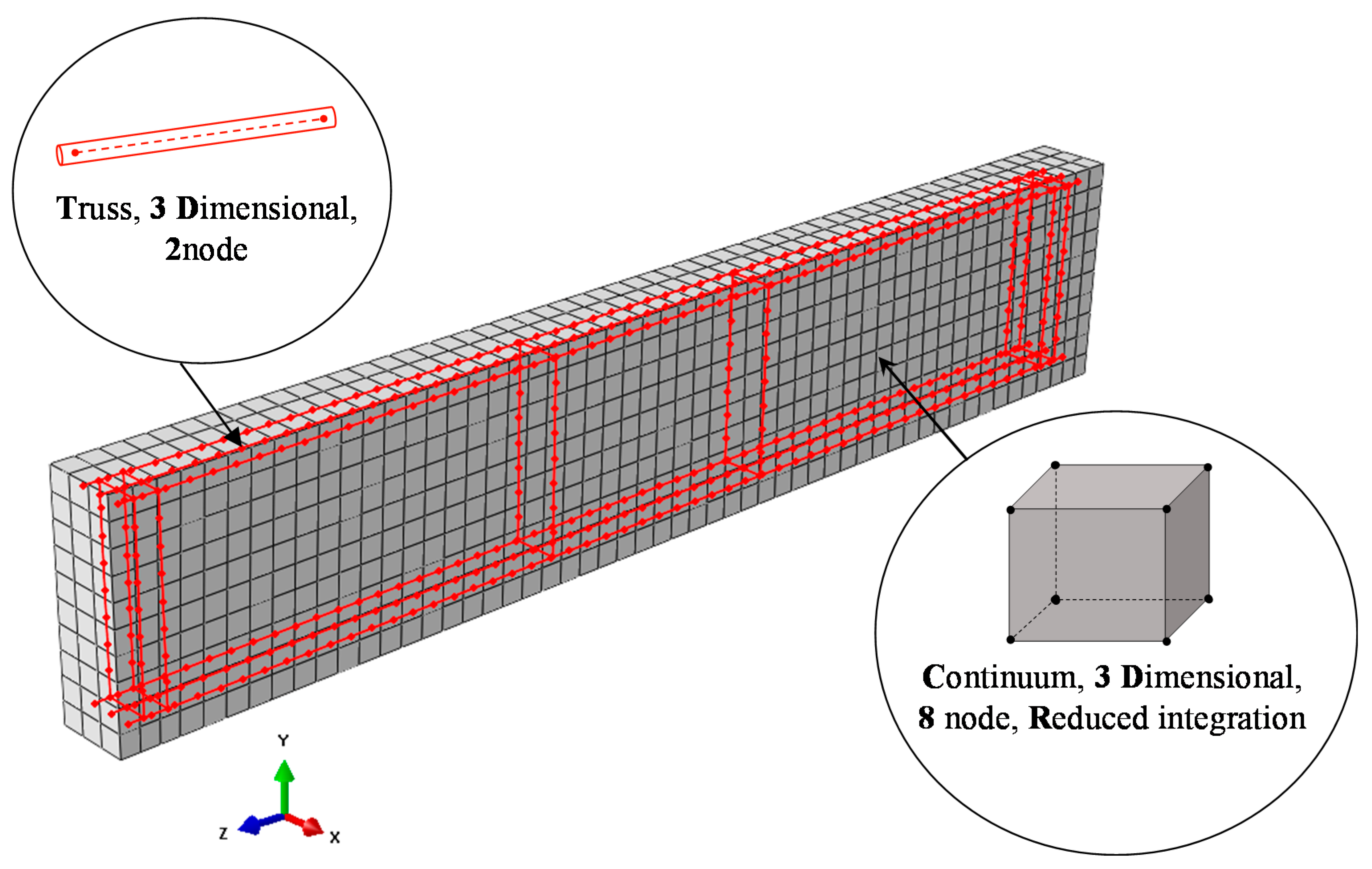

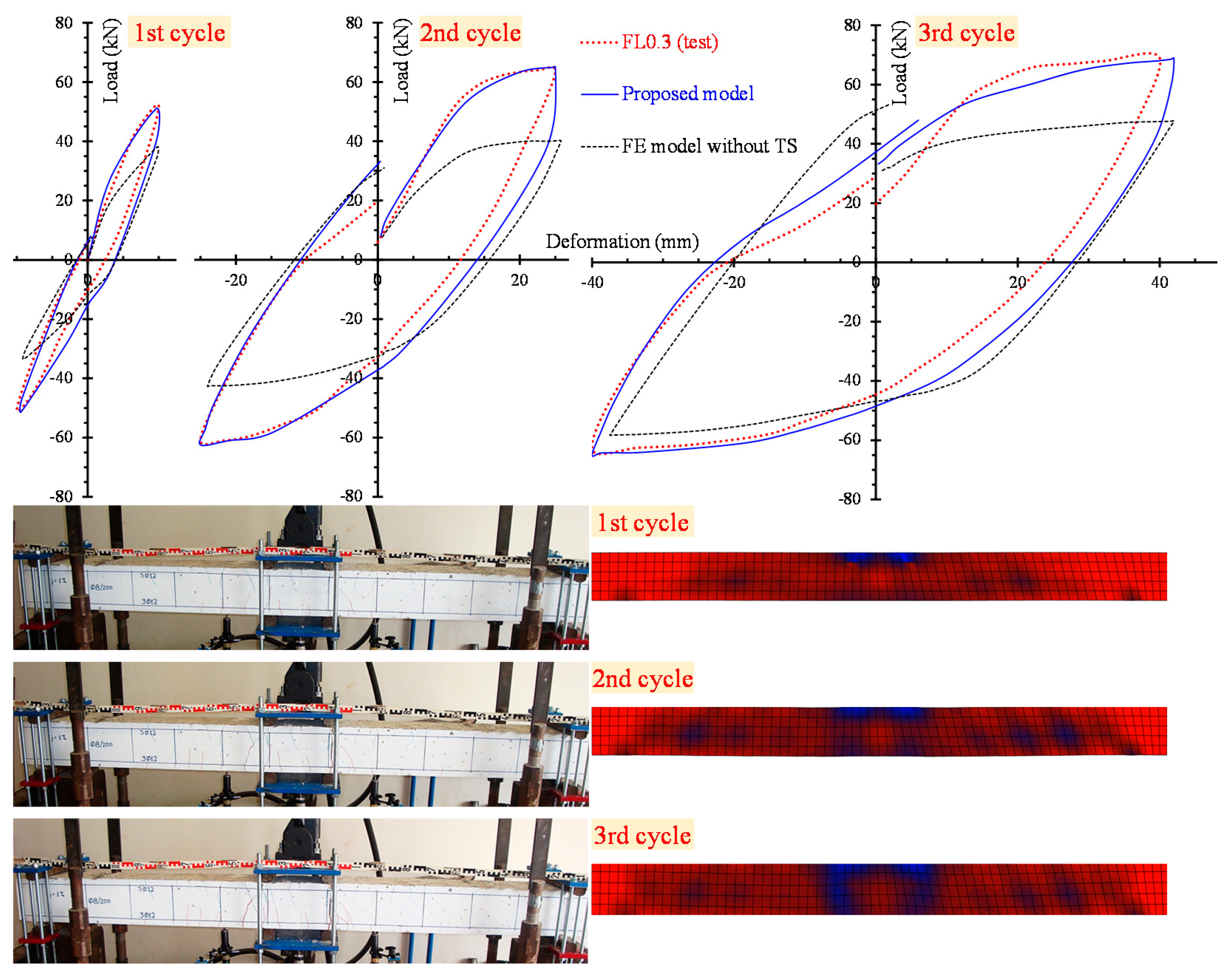

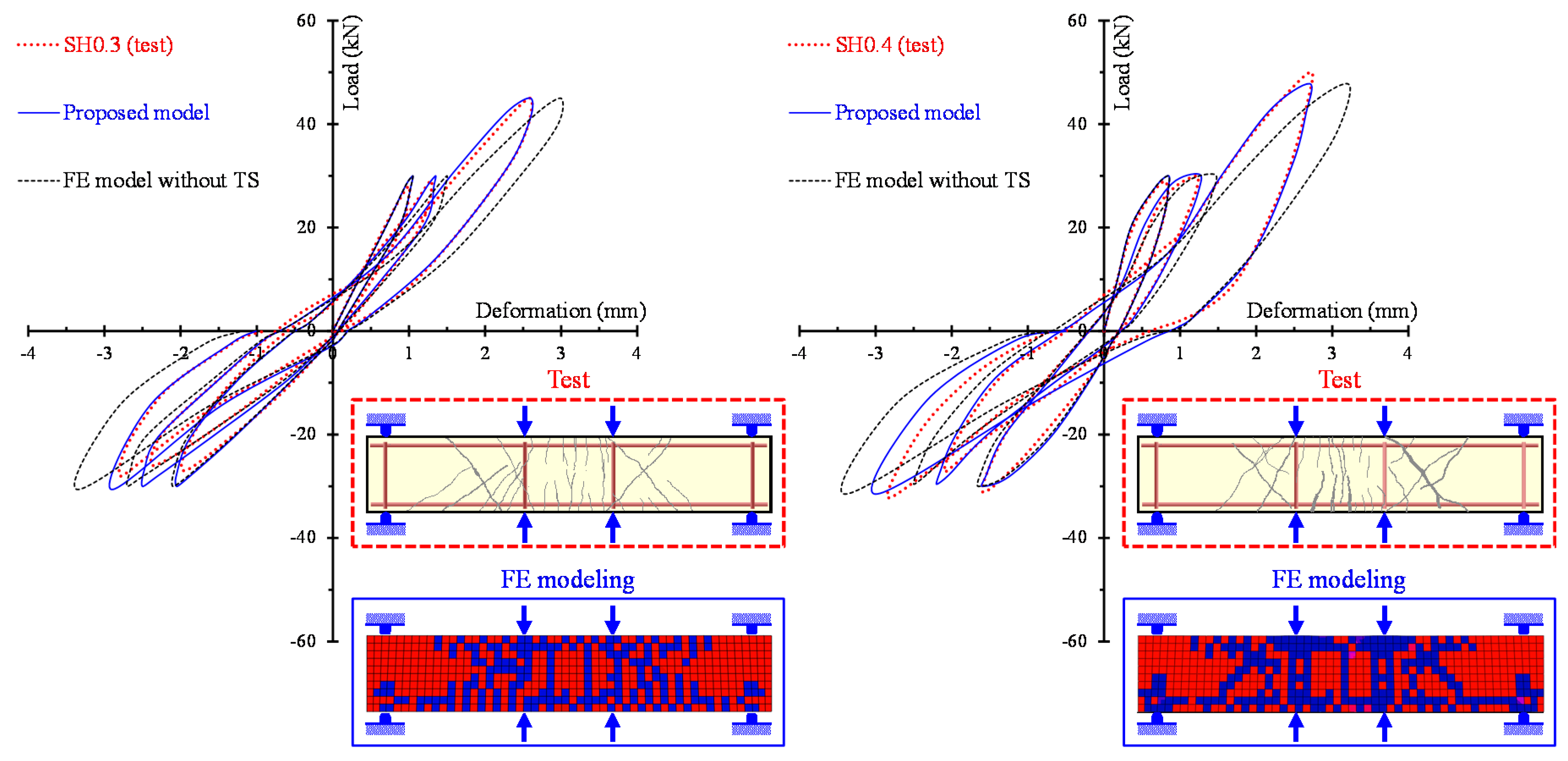
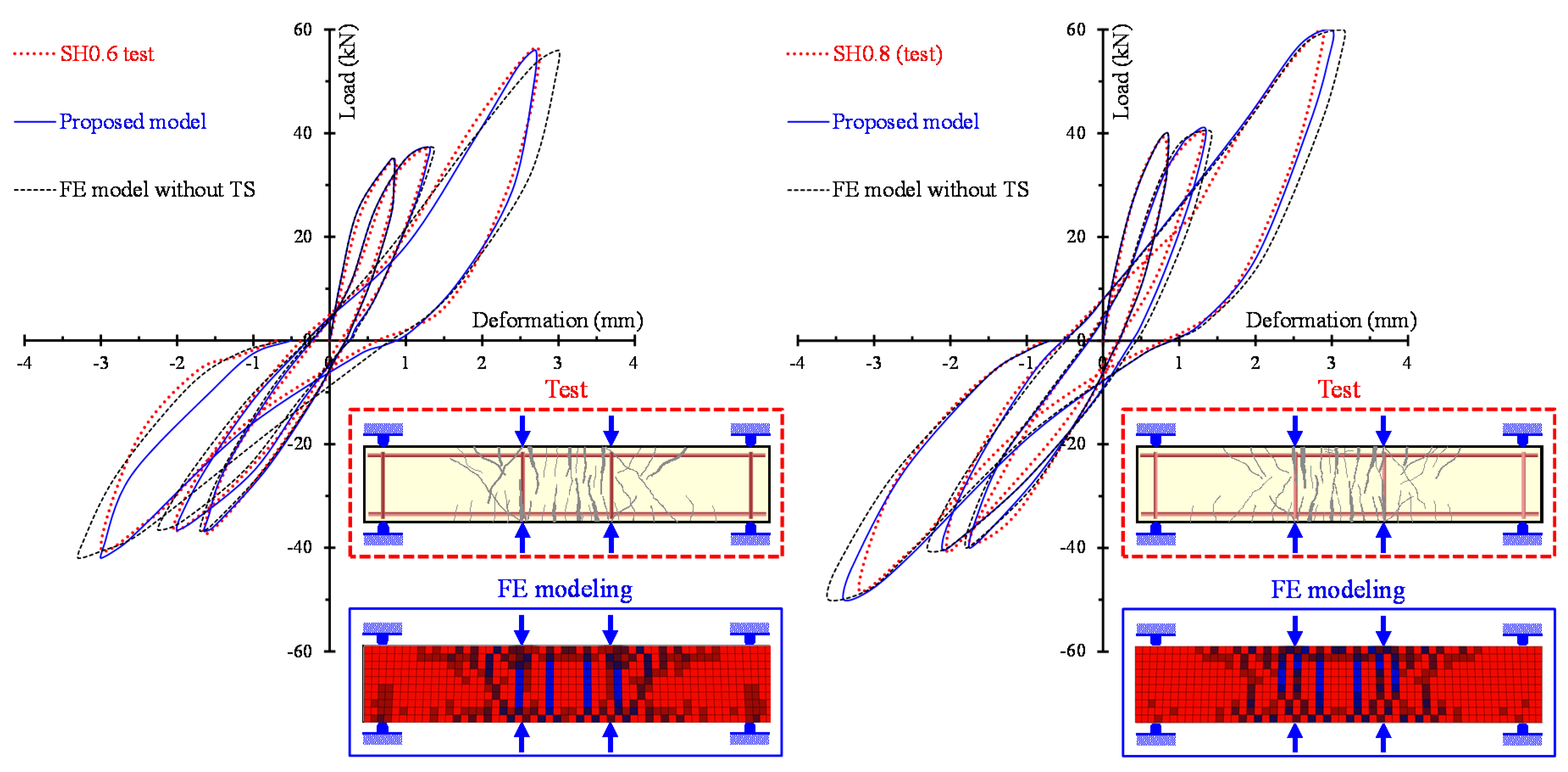

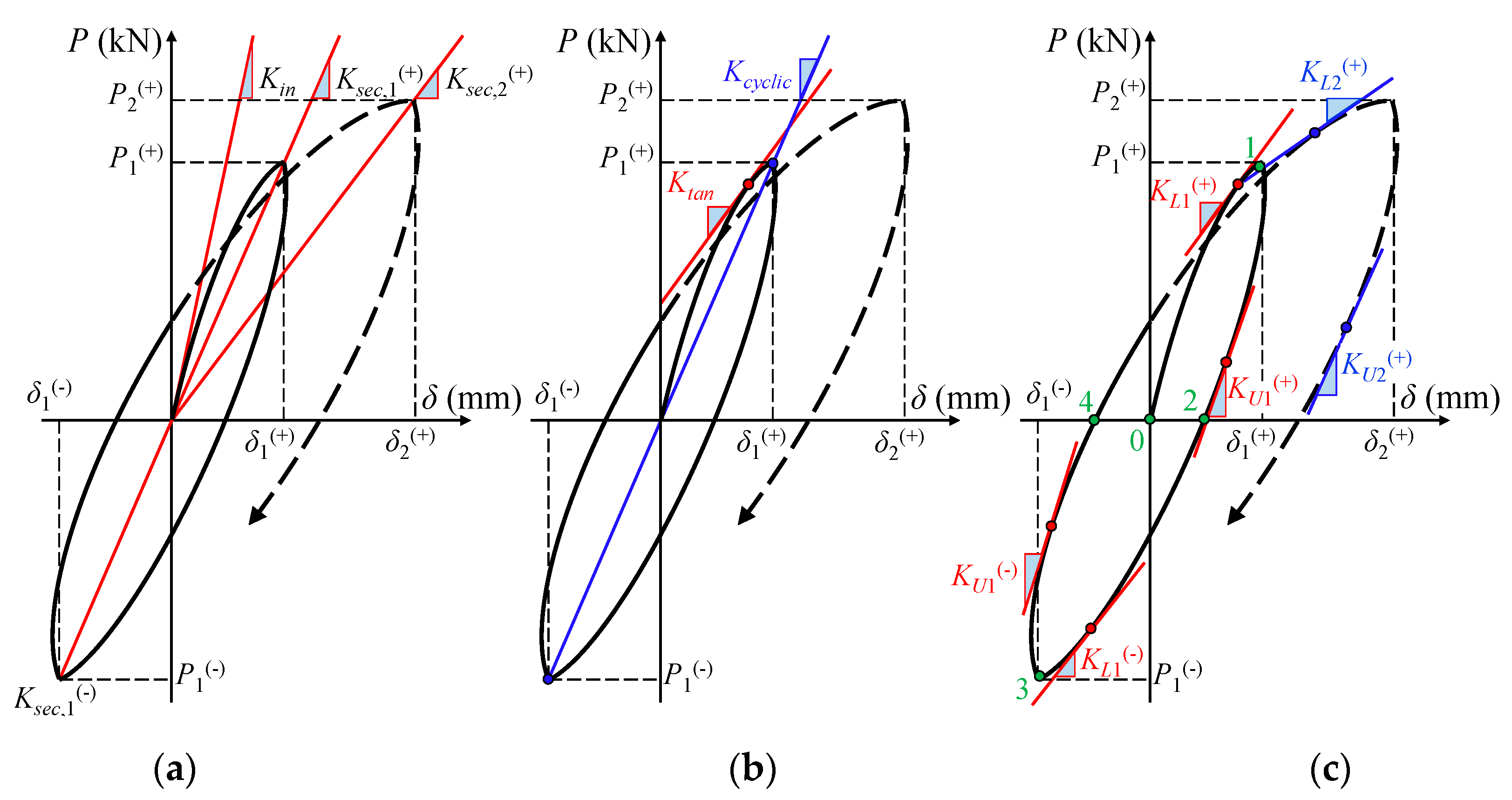

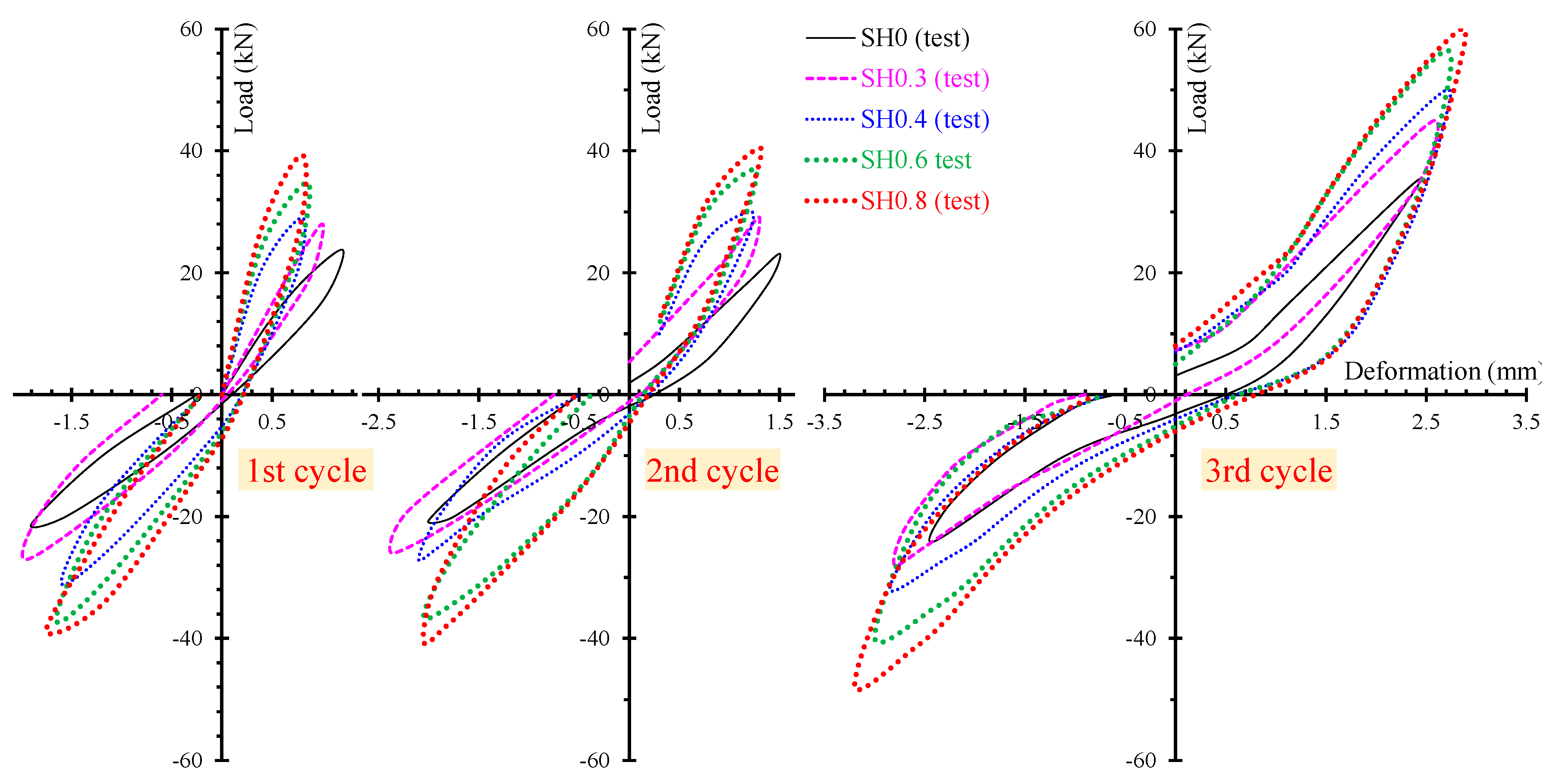
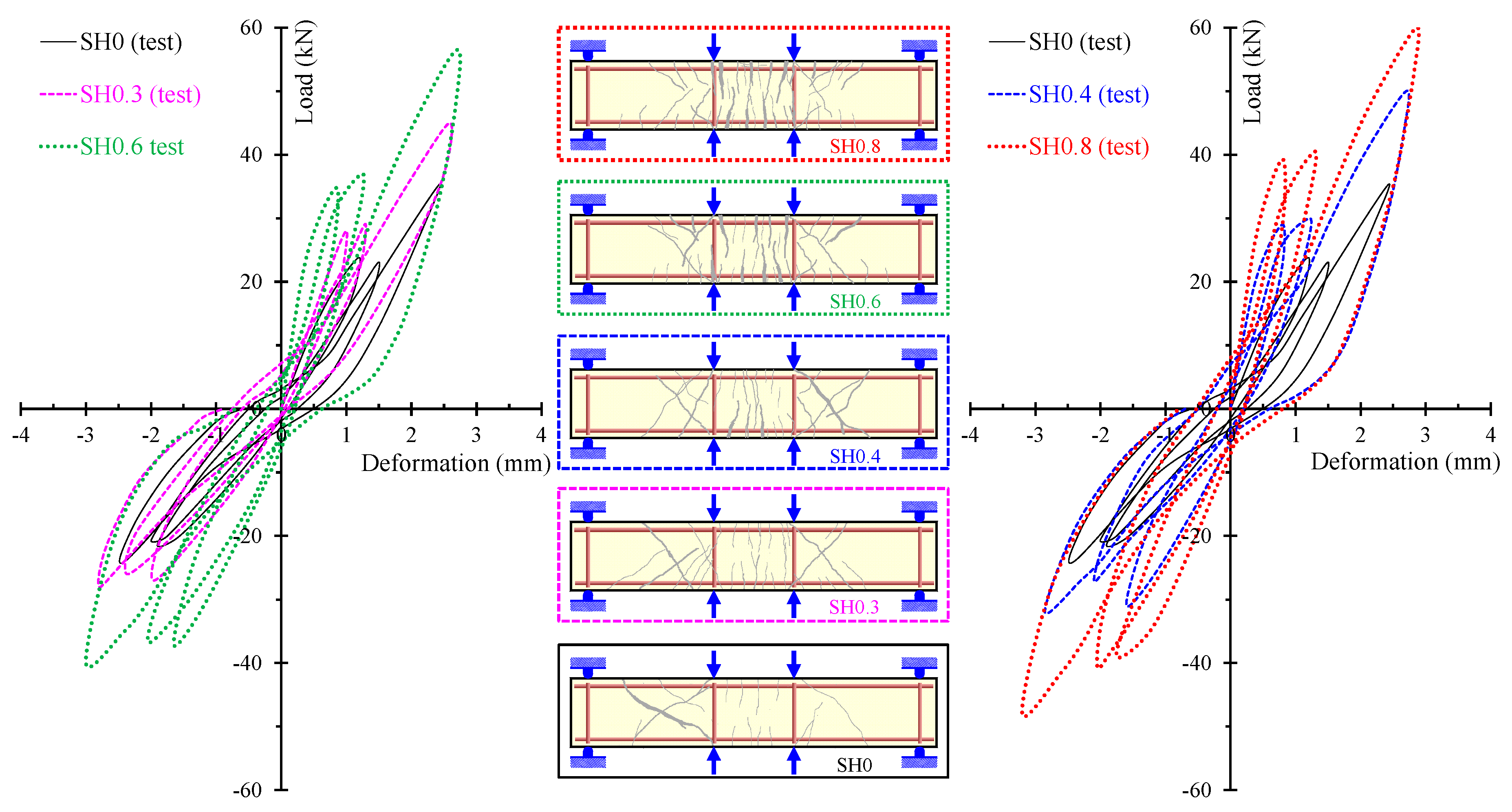


| Group | Beam Name | Geometrical Data | Steel Reinforcement (Bars and Stirrups) | Steel Fiber Characteristics * | ||||||||||
|---|---|---|---|---|---|---|---|---|---|---|---|---|---|---|
| b (mm) | h (mm) | d (mm) | as (mm) | as/d | As1 = As2 (Ø in mm) | ρl1 = ρl2 (%) | Øw/s (mm/mm) | ρw (%) | fy (MPa) | VSF (%) | lSF/dSF (mm/mm) | F | ||
| “FL” | FL0.3 | 200 | 200 | 170 | 1000 | 5.9 | 3Ø12 | 1.00 | Ø8/200 | 0.25 | 590 | 1.00 | 44/1.0 | 0.3 |
| FL1.0 | 200 | 200 | 170 | 1000 | 5.9 | 3Ø12 | 1.00 | Ø8/200 | 0.25 | 590 | 3.00 | 44/1.0 | 1.0 | |
| “SH-s” | SH0-s37 | 100 | 300 | 275 | 550 | 2.0 | 3Ø8 | 0.55 | Ø8/275 | 0.37 | 575 | – | – | – |
| SH0-s50 | 100 | 300 | 275 | 550 | 2.0 | 3Ø8 | 0.55 | Ø8/200 | 0.50 | 575 | – | – | – | |
| SH0.3-s37 | 100 | 300 | 275 | 550 | 2.0 | 3Ø8 | 0.55 | Ø8/275 | 0.37 | 575 | 0.50 | 60/0.8 | 0.3 | |
| SH0.3-s50 | 100 | 300 | 275 | 550 | 2.0 | 3Ø8 | 0.55 | Ø8/200 | 0.50 | 575 | 0.50 | 60/0.8 | 0.3 | |
| “SH” | SH0 | 100 | 300 | 275 | 550 | 2.0 | 3Ø8 | 0.55 | – | – | 575 | – | – | – |
| SH0.3 | 100 | 300 | 275 | 550 | 2.0 | 3Ø8 | 0.55 | – | – | 575 | 0.50 | 60/0.8 | 0.3 | |
| SH0.4 | 100 | 300 | 275 | 550 | 2.0 | 3Ø8 | 0.55 | – | – | 575 | 0.75 | 60/0.8 | 0.4 | |
| SH0.6 | 100 | 300 | 275 | 550 | 2.0 | 3Ø8 | 0.55 | – | – | 575 | 1.00 | 60/0.8 | 0.6 | |
| SH0.8 | 100 | 300 | 275 | 550 | 2.0 | 3Ø8 | 0.55 | – | – | 575 | 1.50 | 60/0.8 | 0.8 | |
| Group | Beam Name | Εc = Et,SF (GPa) | fc,SF (MPa) | εcu,SF (mm/m) | ft,SF (MPa) | kf | Gf,SF (N/mm) | εto,SF (mm/m) | kw |
|---|---|---|---|---|---|---|---|---|---|
| “FL” | FL0.3 | 29.336 | 25.51 | 3.59 | 3.30 | 0.19 | 2.001 | 0.113 | 0.01 |
| FL1.0 | 30.442 | 27.25 | 8.47 | 4.39 | 0.43 | 8.561 | 0.144 | 0.01 | |
| “SH-s” | SH0.3-s37 | 30.055 | 28.76 | 3.43 | 2.39 | 0.22 | 0.655 | 0.080 | 0.04 |
| SH0.3-s50 | 30.055 | 28.76 | 3.43 | 2.39 | 0.22 | 0.655 | 0.080 | 0.04 | |
| “SH” | SH0.3 | 30.055 | 28.76 | 3.43 | 2.39 | 0.22 | 0.601 | 0.080 | 0.04 |
| SH0.4 | 30.264 | 29.64 | 4.33 | 2.44 | 0.33 | 0.892 | 0.081 | 0.04 | |
| SH0.6 | 30.474 | 30.52 | 5.33 | 2.69 | 0.40 | 1.397 | 0.088 | 0.04 | |
| SH0.8 | 30.893 | 32.27 | 7.64 | 2.79 | 0.57 | 2.084 | 0.090 | 0.04 |
| Parameter | Value |
| ψ | 40° |
| Kc | 2/3 |
| σb0/σc0 | 1.16 |
| ∈ | 0.10 |
| μ | 0.0001 |
| Beam Name | ν | σt1 (MPa) | wt1 (mm) | εt1 (mm/m) | σt2 (MPa) | wt2 (mm) | εt2 (mm/m) | σt3 (MPa) | wt3 (mm) | εt3 (mm/m) | dt1 | dt2 | dt3 |
|---|---|---|---|---|---|---|---|---|---|---|---|---|---|
| FL0.3 | 0.212 | 2.56 | 0.012 | 0.09 | 1.07 | 0.034 | 0.26 | 0.62 | 0.045 | 0.34 | 0.225 | 0.676 | 0.811 |
| FL1.0 | 0.237 | 3.69 | 0.013 | 0.10 | 2.29 | 0.041 | 0.31 | 1.87 | 0.053 | 0.40 | 0.159 | 0.478 | 0.573 |
| SH0.3-s37 | 0.210 | 1.87 | 0.011 | 0.06 | 0.84 | 0.032 | 0.18 | 0.53 | 0.045 | 0.25 | 0.219 | 0.656 | 0.787 |
| SH0.3-s50 | 0.210 | 1.87 | 0.011 | 0.06 | 0.84 | 0.032 | 0.18 | 0.53 | 0.045 | 0.25 | 0.219 | 0.656 | 0.787 |
| SH0.3 | 0.210 | 1.87 | 0.011 | 0.06 | 0.84 | 0.032 | 0.18 | 0.53 | 0.043 | 0.24 | 0.216 | 0.648 | 0.778 |
| SH0.4 | 0.216 | 1.98 | 0.011 | 0.06 | 1.07 | 0.032 | 0.18 | 0.80 | 0.041 | 0.23 | 0.187 | 0.561 | 0.673 |
| SH0.6 | 0.215 | 2.24 | 0.011 | 0.06 | 1.33 | 0.034 | 0.19 | 1.06 | 0.045 | 0.25 | 0.168 | 0.504 | 0.605 |
| SH0.8 | 0.231 | 2.46 | 0.011 | 0.06 | 1.79 | 0.032 | 0.18 | 1.59 | 0.043 | 0.24 | 0.119 | 0.357 | 0.428 |
| Beam Name | MAE at Each Cycle | Overall MAE | SE | CV | |||||
|---|---|---|---|---|---|---|---|---|---|
| Cycle 1 | Cycle 2 | Cycle 3 | Cycle 4 | Cycle 5 | |||||
| FL0.3 | A | 1.6% | 1.8% | 1.7% | – | – | 1.7% | 0.4% | 26% |
| B | 30.3% | 33.8% | 19.2% | – | – | 27.8% | 4.3% | 16% | |
| FL1.0 | A | 2.6% | 1.9% | 2.2% | – | – | 2.2% | 0.3% | 12% |
| B | 25.4% | 13.2% | 12.7% | – | – | 17.1% | 4.6% | 27% | |
| SH0.3-s37 | A | 1.6% | 9.5% | 3.9% | 7.7% | 6.8% | 5.9% | 1.7% | 29% |
| B | 3.2% | 4.2% | 17.6% | 25.7% | 19.1% | 13.9% | 3.7% | 26% | |
| SH0.3-s50 | A | 0.1% | 5.6% | 1.1% | 8.1% | 6.2% | 4.2% | 1.5% | 36% |
| B | 3.1% | 22.2% | 22.4% | 26.9% | 24.2% | 19.8% | 3.7% | 19% | |
| SH0.3 | A | 5.1% | 5.1% | 1.8% | – | – | 4.0% | 0.9% | 23% |
| B | 6.3% | 15.1% | 17.5% | – | – | 13.0% | 2.2% | 17% | |
| SH0.4 | A | 3.9% | 3.6% | 2.6% | – | – | 3.4% | 1.0% | 27% |
| B | 4.7% | 18.9% | 18.9% | – | – | 14.2% | 3.0% | 20% | |
| SH0.6 | A | 0.1% | 3.2% | 0.0% | – | – | 1.1% | 0.7% | 64% |
| B | 1.6% | 8.9% | 10.6% | – | – | 7.0% | 1.8% | 26% | |
| SH0.8 | A | 3.2% | 3.1% | 5.8% | – | – | 4.0% | 1.0% | 24% |
| B | 4.6% | 9.9% | 11.5% | – | – | 8.7% | 1.5% | 18% | |
| Beam Name | MAE at Each Cycle | Overall MAE | SE | CV | ||||||||||
|---|---|---|---|---|---|---|---|---|---|---|---|---|---|---|
| Cycle 1 | Cycle 2 | Cycle 3 | Cycle 4 | Cycle 5 | ||||||||||
| Ktan(+) | Ktan(-) | Ktan(+) | Ktan(-) | Ktan(+) | Ktan(-) | Ktan(+) | Ktan(-) | Ktan(+) | Ktan(-) | |||||
| FL0.3 | A | 1.8% | 3.5% | 8.3% | 14.2% | 6.0% | 6.1% | – | – | – | – | 6.7% | 1.6% | 24.3% |
| B | 31.8% | 41.5% | 30.5% | 28.4% | 35.8% | 24.5% | – | – | – | – | 32.1% | 2.0% | 6.1% | |
| FL1.0 | A | 5.9% | 4.4% | 21.6% | 13.3% | 4.1% | 11.7% | – | – | – | – | 10.2% | 2.4% | 24.0% |
| B | 25.6% | 30.9% | 17.4% | 13.2% | 16.1% | 19.0% | – | – | – | – | 20.4% | 2.5% | 12.5% | |
| SH0.3-s37 | A | 5.4% | 6.4% | 3.2% | 12.5% | 1.1% | 8.0% | 9.2% | 6.6% | 6.6% | 8.3% | 6.7% | 1.3% | 18.8% |
| B | 5.7% | 8.8% | 4.7% | 12.0% | 16.8% | 6.7% | 23.0% | 14.0% | 23.8% | 20.6% | 13.6% | 1.7% | 12.6% | |
| SH0.3-s50 | A | 8.8% | 11.5% | 4.8% | 11.7% | 9.3% | 5.1% | 9.4% | 6.2% | 13.3% | 1.3% | 8.1% | 1.0% | 12.6% |
| B | 8.0% | 8.0% | 7.2% | 10.4% | 23.0% | 18.6% | 26.7% | 16.7% | 23.4% | 19.9% | 16.2% | 1.9% | 12.0% | |
| SH0.3 | A | 4.5% | 9.3% | 7.2% | 23.1% | 10.8% | 6.1% | – | – | – | – | 10.1% | 2.9% | 28.7% |
| B | 3.5% | 7.4% | 9.2% | 14.1% | 3.8% | 9.9% | – | – | – | – | 8.0% | 2.1% | 26.2% | |
| SH0.4 | A | 8.0% | 5.4% | 14.2% | 6.2% | 7.5% | 24.3% | – | – | – | – | 10.9% | 2.5% | 22.5% |
| B | 8.0% | 6.1% | 22.7% | 9.8% | 20.2% | 30.3% | – | – | – | – | 16.2% | 3.1% | 19.2% | |
| SH0.6 | A | 14.8% | 10.4% | 17.6% | 7.0% | 6.5% | 8.4% | – | – | – | – | 10.8% | 1.5% | 14.1% |
| B | 13.4% | 10.4% | 23.0% | 11.1% | 12.4% | 21.5% | – | – | – | – | 15.3% | 2.0% | 13.1% | |
| SH0.8 | A | 12.9% | 7.4% | 11.0% | 18.2% | 10.4% | 6.9% | – | – | – | – | 11.2% | 2.3% | 20.4% |
| B | 12.9% | 9.2% | 16.2% | 6.2% | 11.7% | 7.2% | – | – | – | – | 10.6% | 2.2% | 20.9% | |
| Beam Name | MAE at Each Cycle | Overall MAE | SE | CV | |||||
|---|---|---|---|---|---|---|---|---|---|
| Cycle 1 | Cycle 2 | Cycle 3 | Cycle 4 | Cycle 5 | |||||
| FL0.3 | A | 4.7% | 1.8% | 4.0% | – | – | 3.5% | 1.0% | 28.2% |
| B | 25.9% | 36.1% | 29.7% | – | – | 30.6% | 1.9% | 6.2% | |
| FL1.0 | A | 8.3% | 12.5% | 4.1% | – | – | 8.3% | 1.8% | 21.5% |
| B | 22.1% | 1.9% | 12.0% | – | – | 12.0% | 4.3% | 35.9% | |
| SH0.3-s37 | A | 4.8% | 0.4% | 4.0% | 8.1% | 11.1% | 5.7% | 1.7% | 30.1% |
| B | 5.8% | 8.0% | 15.9% | 19.4% | 20.5% | 13.9% | 2.8% | 19.9% | |
| SH0.3-s50 | A | 7.4% | 1.9% | 6.2% | 12.8% | 10.0% | 7.7% | 1.7% | 21.8% |
| B | 4.0% | 12.0% | 23.0% | 26.0% | 27.9% | 18.6% | 3.4% | 18.3% | |
| SH0.3 | A | 3.9% | 4.4% | 2.8% | – | – | 3.7% | 1.4% | 37.6% |
| B | 2.6% | 5.4% | 11.0% | – | – | 6.3% | 2.1% | 33.4% | |
| SH0.4 | A | 2.9% | 3.0% | 5.4% | – | – | 3.8% | 0.7% | 19.0% |
| B | 4.4% | 11.4% | 18.4% | – | – | 11.4% | 2.8% | 24.3% | |
| SH0.6 | A | 0.9% | 2.9% | 2.9% | – | – | 2.3% | 0.7% | 30.7% |
| B | 2.3% | 7.7% | 7.7% | – | – | 5.9% | 1.5% | 25.1% | |
| SH0.8 | A | 3.3% | 3.0% | 3.5% | – | – | 3.3% | 0.5% | 15.3% |
| B | 2.2% | 9.0% | 8.5% | – | – | 6.6% | 1.6% | 23.8% | |
| Beam Name | MAE at Each Cycle | Overall MAE | SE | CV | |||||
|---|---|---|---|---|---|---|---|---|---|
| Cycle 1 | Cycle 2 | Cycle 3 | Cycle 4 | Cycle 5 | |||||
| FL0.3 | A | 4.6% | 1.8% | 1.0% | – | – | 2.5% | 1.1% | 44.2% |
| B | 25.8% | 33.7% | 19.2% | – | – | 26.2% | 4.2% | 15.9% | |
| FL1.0 | A | 8.2% | 12.4% | 0.3% | – | – | 7.0% | 3.5% | 50.6% |
| B | 22.0% | 3.0% | 11.2% | – | – | 12.1% | 5.5% | 45.4% | |
| SH0.3-s37 | A | 3.7% | 7.5% | 0.0% | 12.1% | 7.3% | 6.1% | 2.0% | 33.1% |
| B | 2.1% | 2.8% | 15.4% | 22.9% | 22.5% | 13.1% | 4.6% | 34.8% | |
| SH0.3-s50 | A | 7.0% | 1.9% | 5.2% | 12.5% | 9.9% | 7.3% | 1.8% | 25.2% |
| B | 3.9% | 12.0% | 22.8% | 25.8% | 23.7% | 17.7% | 4.2% | 23.7% | |
| SH0.3 | A | 3.8% | 3.4% | 1.7% | – | – | 3.0% | 0.7% | 22.0% |
| B | 2.2% | 5.2% | 11.9% | – | – | 6.4% | 2.9% | 44.9% | |
| SH0.4 | A | 2.0% | 6.3% | 5.8% | – | – | 4.7% | 1.3% | 28.5% |
| B | 4.0% | 7.1% | 18.7% | – | – | 9.9% | 4.5% | 44.9% | |
| SH0.6 | A | 0.4% | 0.5% | 1.6% | – | – | 0.8% | 0.4% | 45.4% |
| B | 2.3% | 7.9% | 8.1% | – | – | 6.1% | 1.9% | 31.1% | |
| SH0.8 | A | 0.0% | 2.9% | 3.7% | – | – | 2.2% | 1.1% | 50.2% |
| B | 1.7% | 9.5% | 8.7% | – | – | 6.6% | 2.5% | 37.4% | |
| Group | Beam Name | F | VSF (%) | ρw (%) | Cycle 1 | Cycle 2 | Cycle 3 | Cycle 4 | Cycle 5 |
|---|---|---|---|---|---|---|---|---|---|
| “FL” | FL0.3 | 0.3 | 1.00 | 0.25 | 1.00 | 1.17 | 1.09 | – | – |
| FL1.0 | 1.0 | 3.00 | 0.25 | 1.00 | 1.28 | 1.20 | – | – | |
| “SH-s” | SH0.3-s37 | 0.3 | 0.50 | 0.37 | 1.33 | 1.80 | 1.59 | 1.26 | 1.49 |
| SH0.3-s50 | 0.3 | 0.50 | 0.50 | 1.42 | 1.73 | 1.40 | 1.21 | 1.27 | |
| “SH” | SH0.3 | 0.3 | 0.50 | – | 1.38 | 1.60 | 1.60 | – | – |
| SH0.4 | 0.4 | 0.75 | – | 1.40 | 1.67 | 2.40 | – | - | |
| SH0.6 | 0.6 | 1.00 | – | 1.73 | 2.08 | 3.09 | – | – | |
| SH0.8 | 0.8 | 1.50 | – | 1.98 | 2.55 | 3.47 | – | – |
© 2020 by the authors. Licensee MDPI, Basel, Switzerland. This article is an open access article distributed under the terms and conditions of the Creative Commons Attribution (CC BY) license (http://creativecommons.org/licenses/by/4.0/).
Share and Cite
K. Kytinou, V.; E. Chalioris, C.; G. Karayannis, C.; Elenas, A. Effect of Steel Fibers on the Hysteretic Performance of Concrete Beams with Steel Reinforcement—Tests and Analysis. Materials 2020, 13, 2923. https://doi.org/10.3390/ma13132923
K. Kytinou V, E. Chalioris C, G. Karayannis C, Elenas A. Effect of Steel Fibers on the Hysteretic Performance of Concrete Beams with Steel Reinforcement—Tests and Analysis. Materials. 2020; 13(13):2923. https://doi.org/10.3390/ma13132923
Chicago/Turabian StyleK. Kytinou, Violetta, Constantin E. Chalioris, Chris G. Karayannis, and Anaxagoras Elenas. 2020. "Effect of Steel Fibers on the Hysteretic Performance of Concrete Beams with Steel Reinforcement—Tests and Analysis" Materials 13, no. 13: 2923. https://doi.org/10.3390/ma13132923








